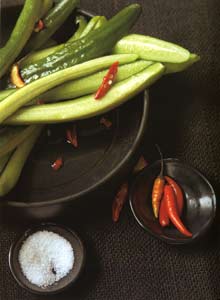An Excerpt From:
Noodles Every Day
Delicious Asian Recipes from Ramen to Rice Sticks
by Corinne Trang
Photographs by Maura McEvoy
Chronicle Books, San Francisco
Copyright 2009
168 Pages
$22.95
ISBN 978-0-8118-6143-4
Available on Amazon.com here.
Excerpt by permission of the publisher.
Here I explore the idea that these small Asian snack dishes can be the foundations for quick, healthful, and wondrously varied meals, which can be prepared by any home cook. Most include only a few ingredients, go from package and cutting board to skillet and table in about 30 minutes or less, and require no special skills or foreknowledge of Asian cooking to prepare. They can be enjoyed by dyed-in-the-wool meat eaters, vegetarians of all stripes, and serious vegans–depending on the recipe selected and how the ingredients are parsed out. Almost everything you need to succeed in creating great recipes and bold flavors can be found in the international foods aisle of your local supermarket. And the recipes in this book will allow you to extend your range once you master the basics. In essence, if you can make spaghetti, you can cook these dishes.
My hope, then, is to wrestle the extraordinary diversity of Asian noodles into a few categories, and to proceed wtih a sense of adventure and invention. Broadly speaking, you can group Asian noodles into dry and fresh types, and break them down by main ingredient from there. Surprisingly, perhaps, you won’t need any extensive understanding of country of origin because most of these noodles are used all throughout Asia. When it makes sense, I give the name of the Italian pasta that is roughly equivalent as a sort of shorthand. When an item is unusual or especially suited to a dish, I do identify it as such. And I give the traditional names of specific dishes and note their roots when appropriate.
Sweet, Sour, and Spicy Fish Sauce
This sweet and sour fish sauce dip is made spicy with chopped chilies and garlic, while fresh-squeezed lime or lemon gives it a sour edge. Called nuoc cham or nuoc mam cham in Vietnamese, it is the ubiquitous condiment of the Vietnamese table. Drizzle it over grilled meat set atop thin rice noodles tossed with shredded vegetables for refreshing fare, perfect for summer.
1/2 cup fish sauce
1/2 cup sugar
1/2 cup fresh lime or lemon juice
1 large garlic clove, thinly sliced or minced
1 to 2 fresh red Thai chilies, stemmed, seeded, and thinly sliced or minced
In a medium bowl, whisk together the fish sauce and sugar until the sugar is completely dissolved. Stir in the lime or lemon juice and add the garlic and chilies. Let steep for 20 minutes or so before serving. Refrigerate in an airtight container for up to 1 week.
Makes 1 1/2 cups.
Asian-Style Kirby Pickles
I don’t know about you, but I like to nibble on sweet, salty, and tangy vegetable pickles with my meals. They help digest food and provide balance during the meal, especially when you are eating starchy foods like noodles. They also whet the appetite, which is probably why they are served the minute you sit down in many Asian restaurants. I call for kirby, Persian, or Japanese cucumbers, all of which are slender when compared to regular cucumbers. Kirby and Persian pickles are 4 to 5 inches long, while Japanese cucumbers are a couple of inches longer. The pickling liquid here is traditionally used for pickling sliced cucumber, carrots, and daikon, so feel free to try these vegetables as well. The amount of pickling liquid may look inadequate, but there will be enough because the cucumbers give up some of their natural water while sitting in the brine.
 12 kirby, Persian, or Japanese cucumbers, quartered lengthwise (see Note)
12 kirby, Persian, or Japanese cucumbers, quartered lengthwise (see Note)
1 tablespoon kosher salt
6 tablespoons sugar
1 cup rice vinegar
1 to 2 red Thai chilies, stemmed, seeded, and halved or coarsely chopped (optional)
In a large bowl, toss the cucumbers with the salt. Let stand for 1 hour. Drain, wipe, and transfer them to a large resealable plastic bag.
In a small bowl, whisk together the sugar and rice vinegar until the sugar is completely dissolved. Pour into the large plastic bag containing the cucumbers, and add the chiles (if using). Seal the bag, squeezing any air out. Refrigerate for at least 12 hours. The longer the vegetables macerate, the more pickled they will taste.
Note: If you like a milder flavor, pickle these small cucumbers whole. Serves 6.





